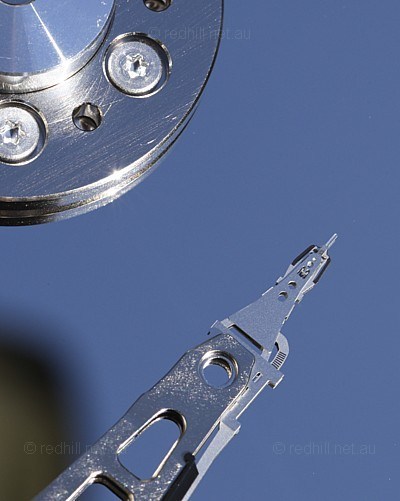
Hitachi Deskstar 180GXP (80GB, 2003).
Update your bookmark
This is the old site. You probably want the new site.
The new site has all the same information but adds more drives, updated text, and much better pictures of many models.
- Seagate Barracuda ATA IV
- Samsung Spinpoint V40
- Western Digital JB Series
- Samsung Spinpoint P40
- Samsung SpinPoint P80
- Samsung Spinpoint P120 new
This old version of the Red Hill guide hasn't been updated for about ten years. The new version can be found here.
This was going to be the last year of IDE as we knew it. Everyone thought that the new Serial ATA interface would take over quickly, and with it would come a long overdue overdue increase in ATA spindle speeds to 10,000 RPM. Serial ATA went nowhere and even now, in mid 2005, ATA-100 remains the standard. SATA still hasn't managed to provide any tangible benefit; it costs more, and the flimsy connectors are very badly designed. It will probably be 2006 before SATA becomes the rule rather than the exception.
The 10,000 RPM spindle speed came along, but only in a single model, the lack-lustre Western Digital Raptor, which performed quite well but quickly developed a reputation for poor reliability. We avoided them.
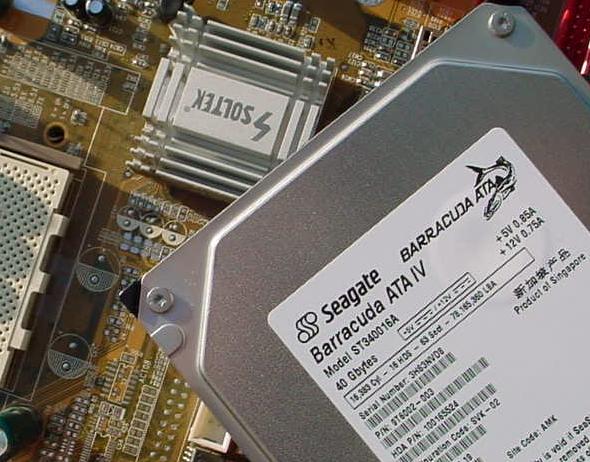
Seagate Barracuda ATA IV
Good news from Seagate after a couple of disappointing 7200 RPM drives. Not by any means a speed demon, but back in touch with the leaders at last.
→ 40GB Barracuda ATA IV and Soltek SL-75KAV main board.
This fifth of the Seagate 7200 RPM IDE drives was astonishingly quiet. It had virtually no idle noise at all and ultra-quiet seeks too — even the Samsung 5400s seemed loud by comparison with a Barracuda IV.
It achieved its quiet seeks, in part, by firmware changes. The ATA IV shipped with acoustic management switched on by default, presumably because Seagate thought that most users couldn't tell the difference (which may well have been true). But if it was true, why did they spend the extra to buy a 7200 RPM drive in the first place? Whatever the reasoning, by slowing the seeks the acoustic management turned what ought to have been a very competitive drive indeed into a near-equivalent of the old Barracuda ATA III - a cheap but rather lack-lustre 7200 RPM product.
| Performance | 1.42 | Reliability | no data |
| Data rate | 555 Mbit/sec | Spin rate | 7200 RPM |
| Seek time | 10.8ms | Buffer | 2MB |
| Platter capacity | 40GB | Interface | ATA-100 |
| ST-320011 | 20GB | 1 GMR head | |
| ST-340016 | 40GB | 2 GMR heads | * |
| ST-360021 | 60GB | 3 GMR heads | * |
| ST-380021 | 80GB | 4 GMR heads | ** |
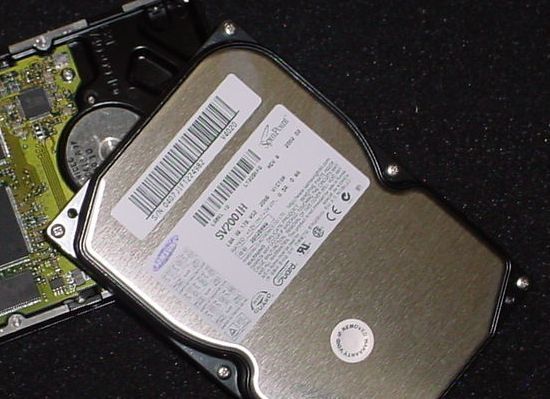
Samsung SpinPoint V40
Another quiet Samsung achiever. The jump to 40GB/platter drives was a major hurdle for the storage industry. Most makers struggled with 40GB/platter yields and quality control early on, but Samsung maintained their superb reliability record with this new and much more difficult to manufacture product. They have been as flawless as ever.
Normally, when a new model drive arrives here, the first thing we do is put it on the test bench and examine its performance. This usually has a big bearing on how many more of them we buy over the next six or twelve months. In the case of the V40 though, we were lax about it — because, in reality, it would have had to turn in terrible benchmarks before we considered stocking anything else as our number one mainstream drive. We have become very fond of our wonderfully fuss-free, utterly reliable Spinpoints these past couple of years, and if push came to shove, we would probably keep on buying them even if they had dropped another millisecond.
When we did finally test the V40 we were pleasantly surprised: Samsung had managed to preserve the exact same seek performance as the old V30. The last two 5400 RPM Spinpoints had each been marginally slower than the one before, another small drop would have threatened to take the Samsung 5400s out of the sweet spot they had occupied for the last two years. It was also encouraging to see that Samsung had finally upped the meagre 512k cache of the V2040 and V30 to the by-this-time standard 2MB, but in the end it is the mechanicals that matter most.
| Performance | 1.39 | Reliability | AA1 |
| Data rate | 443 Mbit/sec | Spin rate | 5400 RPM |
| Seek time | 8.9ms | Buffer | 2MB |
| Platter capacity | 40GB | Interface | ATA-100 |
| SV2001H | 20GB | 1 GMR head | *** |
| SV4002H | 40GB | 2 GMR heads | **** |
| SV6003H | 60GB | 3 GMR heads | * |
| SV8004H | 80GB | 4 GMR heads |
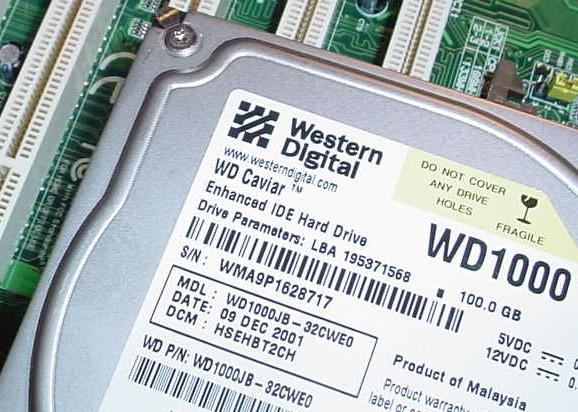
Western Digital JB series
Western Digital's 1000BB and 1200BB models of late 2001 were very high achievers, to be considered in the same breath as the other two best-rated IDE drives on the market: the IBM Deskstar 60GXP and the Maxtor 740DX. Opinions varied as to which should be awarded the performance crown: the WD with its great all-round panache, or the Maxtor with its best-in-class seek performance. (The Quantum heritage lived on somewhere inside Maxtor, it seems.)
The JB drives, however, were a different matter. They were almost identical to the BB series drives that they were based on, differing only in the massive 8MB on-board cache and some firmware optimisations. Western Digital released them as a special limited edition, which is marketing speak for "we don't expect to sell too many of these, but we will slap a high price sticker on them and see how many takers we get". In this industry, special editions are indeed time-limited: they will only make them there are buyers left.
But no matter, the performance is the thing, and the performance of the JB drives was certainly impressive. In a word, our WD1000JB was the fastest IDE drive we have ever laid our hands on. It is not, however, a realistic substitute for the very high RPM, very fast seeking SCSI drives that have always been the ultimate in hard drive performance. Compared to a two year old Cheetah X15 it had a noticeable hesitation and was clearly in a lesser league. But the mere fact that one thinks to compare the JB with an X15 at all shows just how fine an effort the Western Digital drive was. It was less than half the price of an exotic SCSI drive, quieter because of spinning at half the RPM, and it had more than five times as much capacity.
Oddly enough, it was this last advantage that held the JB back so far as sales went: hard drive buyers, by and large, just didn't need 100 or 120 GB of storage space. There wa the odd exceptional user who did, but in 2002 there was barely any retail demand for drives over 60GB, and 80GB drives did not take off until late in the year, when the price difference between an 80 and a 40 had shrunk to less than $100. The JB, in short, was only suited to the buyer who cared enough about performance to spend more than twice as much as usual on a hard drive, but not enough to spend twice as much again on an Atlas 10K III or a Cheetah X15. We would rather have seen a 10,000 RPM spindle in an IDE drive — this step was long overdue — but in the meantime, the JB was the next best thing.
| Performance | 1.54 (1.51) | Reliability | no data |
| Data rate | 602 Mbit/sec (525) | Spin rate | 7200 RPM |
| Seek time | 8.9ms | Buffer | 8MB |
| Platter capacity | 40GB (33) | Interface | ATA-100 |
| WD1000JB | 100GB | 6 GMR head | * |
| WD1200JB | 120GB | 6 GMR heads |
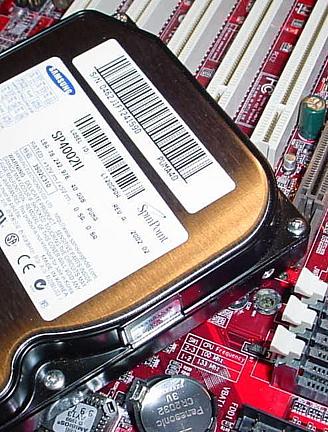
Samsung SpinPoint P40
Samsung's forte had always been their cheap, fast, ultra-reliable 5400 RPM value-class line. This, their third entry in the higher-speed 7200 RPM market, did not stand out from the crowd in the way that their 5400s did, though it remained a worthy drive.
The P40 did not offer quite the same speed that the Western Digital 400BB or the Maxtor 740DX drives did, but fell into the same category as the Seagate Barracuda ATAs: a "value-class" 7200, if you like. Like the Seagate 7200s, it traded a slightly lower price and near-silent operation on the one hand, for slightly lower performance on the other. The way the performance differed was quite different though: the Seagate drives had excellent data transfer rates and good cache optimisation but poor seek performance, where the P40, in traditional Samsung style, did the opposite.
In 5400 RPM drives, Samsung were far and away our favourite brand through '01 and early '02, and we normally only carried other brands to cover shortages. In the 7200s though, we mostly used a mix of the Western Digitals for their performance, and the Samsungs for their slightly lower price and well-proven reliability. (Why the WD and not the 740DX? Because although they are almost universally regarded as excellent drives, here in Australia where Maxtors are a rarity, the 540DX and 740DX are much too expensive and would need to be head and shoulders above the competition to be worth it.)
Around the autumn of 2002 the price of the 40GB P40s dropped to within five dollars of most 5400s and, at that tiny premium, there was no longer any point in carrying 5400 RPM drives at all. We switched to using the P40s for everything bar the 60GB and 80GB sizes. A little later we decided that neither the marginal performance advantage of the Western Digital 7200s nor the noticable price advantage of the Barracuda ATAs — about $15 Australian — was sufficient to outweigh the proven reliability of the Samsung drives. We couldn't find a reason to keep any other drive in stock. The missing 60GB model (which was not sold in Australia) made us ponder Seagate from time to time, but 60GB was a slow-moving category in any case: most buyers were happy to either stay with 40GB or step up to an 80.
| Performance | 1.52 | Reliability | AAA |
| Data rate | 557 Mbit/sec | Spin rate | 7200 RPM |
| Seek time | 8.9ms | Buffer | 2MB |
| Platter capacity | 40GB | Interface | ATA-100 |
| SP2001H | 20GB | 1 GMR head | |
| SP4002H | 40GB | 2 GMR heads | ***** |
| SP6003H | 60GB | 3 GMR heads | |
| SP8004H | 80GB | 4 GMR heads | ** |


